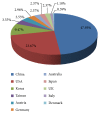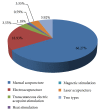The Status of the Quality Control in Acupuncture-Neuroimaging Studies
- PMID: 27242911
- PMCID: PMC4875991
- DOI: 10.1155/2016/3685785
The Status of the Quality Control in Acupuncture-Neuroimaging Studies
Abstract
Using neuroimaging techniques to explore the central mechanism of acupuncture gains increasing attention, but the quality control of acupuncture-neuroimaging study remains to be improved. We searched the PubMed Database during 1995 to 2014. The original English articles with neuroimaging scan performed on human beings were included. The data involved quality control including the author, sample size, characteristics of the participant, neuroimaging technology, and acupuncture intervention were extracted and analyzed. The rigorous inclusion and exclusion criteria are important guaranty for the participants' homogeneity. The standard operation process of acupuncture and the stricter requirement for acupuncturist play significant role in quality control. More attention should be paid to the quality control in future studies to improve the reproducibility and reliability of the acupuncture-neuroimaging studies.
Figures




References
-
- Eisemberg D. M., Kessler R. C., Foster C., et al. Unconventional medicine in the United States. The New England Journal of Medicine. 1993;328:246–252. - PubMed
-
- Elsenberg D. M., Davis R. B., Ethmer S. C. Trend in alternative medicines use in the United States. The Journal of the American Medical Association. 1990;280:1569–1575.
-
- Kerr Grieve J., Flucker S., O'Riordan J. Acupuncture is an effective treatment for pain and other mssymptoms. Journal of Neurology, Neurosurgery & Psychiatry. 2013;84, article e2
Publication types
LinkOut - more resources
Full Text Sources
Other Literature Sources

